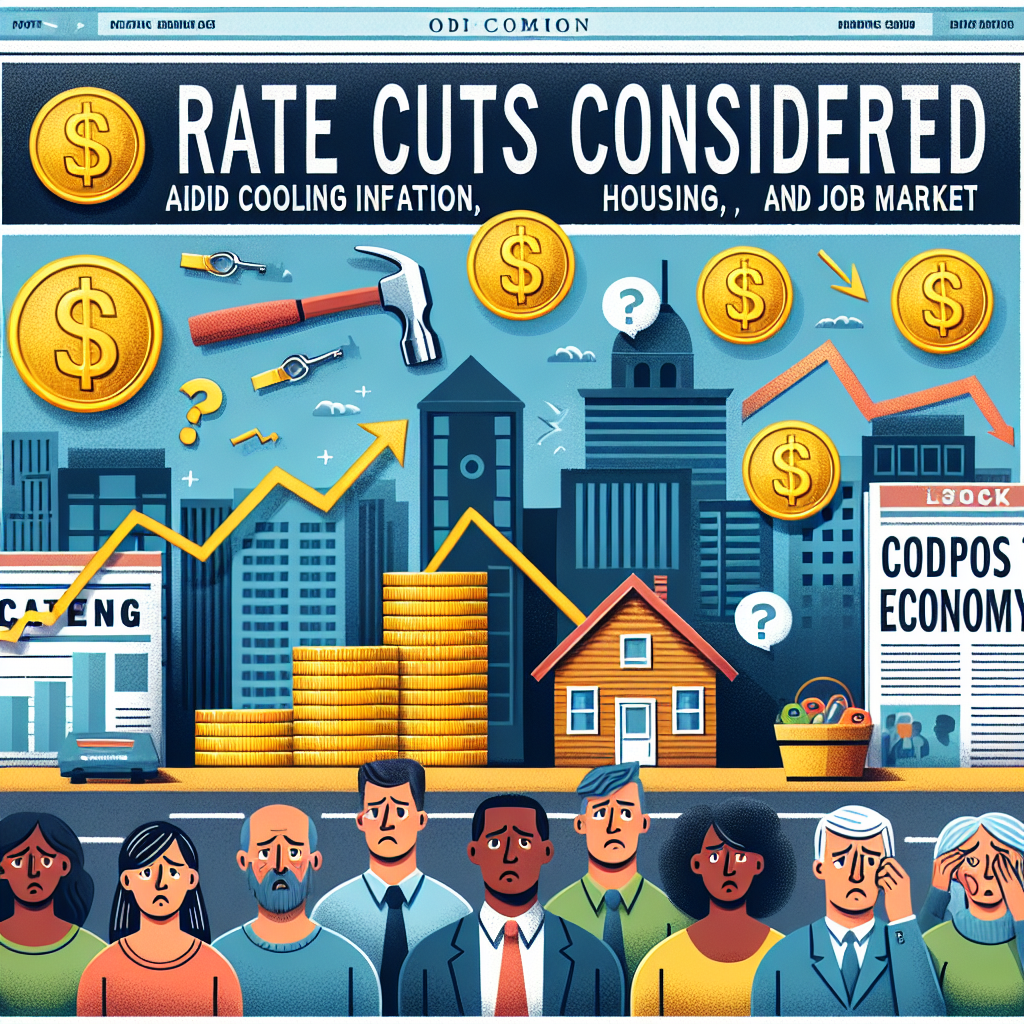-
Table of Contents
- Rate Cuts Considered Amid Cooling Inflation, Housing, and Job Market
- Understanding Rate Cuts
- Cooling Inflation
- Global Inflation Trends
- Impact on Monetary Policy
- Sluggish Housing Market
- Current State of the Housing Market
- Factors Contributing to the Slowdown
- Potential Benefits of Rate Cuts
- Softening Job Market
- Job Market Indicators
- Factors Contributing to Job Market Softening
- Implications for Monetary Policy
- Case Studies: Rate Cuts in Action
- United States: The Great Recession
- Eurozone: Sovereign Debt Crisis
- Potential Risks and Challenges
- Inflationary Pressures
- Financial Stability
- Limited Policy Space
- Conclusion
Rate Cuts Considered Amid Cooling Inflation, Housing, and Job Market

As the global economy navigates through a period of significant change, central banks are increasingly considering rate cuts to stimulate growth. This article delves into the factors driving these considerations, focusing on cooling inflation, a sluggish housing market, and a softening job market. We will explore the implications of potential rate cuts, supported by relevant examples, case studies, and statistics.
Understanding Rate Cuts
Rate cuts refer to the reduction of interest rates by central banks, which can influence borrowing costs, consumer spending, and overall economic activity. Lower interest rates make borrowing cheaper, encouraging businesses to invest and consumers to spend, thereby stimulating economic growth.
Cooling Inflation
Inflation, the rate at which the general level of prices for goods and services rises, has been a significant concern for policymakers. However, recent data suggests a cooling trend in inflation rates across several major economies.
Global Inflation Trends
According to the International Monetary Fund (IMF), global inflation is projected to decline from 4.7% in 2022 to 3.5% in 2023. This cooling trend is attributed to several factors:
- Improved supply chain conditions
- Stabilization of commodity prices
- Monetary tightening measures implemented by central banks
For instance, the United States saw its inflation rate drop from a peak of 9.1% in June 2022 to 5.4% by mid-2023. Similarly, the Eurozone experienced a decline from 8.6% to 4.3% over the same period.
Impact on Monetary Policy
As inflation cools, central banks have more leeway to consider rate cuts without the risk of exacerbating price pressures. The Federal Reserve, European Central Bank (ECB), and other major central banks are closely monitoring inflation trends to determine the appropriate timing for potential rate cuts.
Sluggish Housing Market
The housing market is another critical factor influencing the consideration of rate cuts. A sluggish housing market can have far-reaching implications for the broader economy.
Current State of the Housing Market
Several indicators point to a slowdown in the housing market:
- Declining home sales
- Falling home prices
- Reduced construction activity
For example, in the United States, existing home sales fell by 12% year-over-year in the first quarter of 2023. Similarly, the UK experienced a 10% decline in home prices over the same period.
Factors Contributing to the Slowdown
The housing market slowdown can be attributed to several factors:
- Higher mortgage rates: Rising interest rates have made borrowing more expensive, reducing affordability for potential homebuyers.
- Economic uncertainty: Concerns about economic stability have led to cautious consumer behavior.
- Supply chain disruptions: Ongoing supply chain issues have delayed construction projects and increased costs.
Potential Benefits of Rate Cuts
Rate cuts can help revive the housing market by lowering mortgage rates, making home loans more affordable. This can stimulate demand for homes, boost construction activity, and support related industries such as real estate and home improvement.
Softening Job Market
The job market is a crucial indicator of economic health. Recent data suggests a softening job market, which has implications for monetary policy decisions.
Job Market Indicators
Several key indicators point to a softening job market:
- Rising unemployment rates
- Slower job creation
- Increased jobless claims
For instance, the United States saw its unemployment rate rise from 3.5% in early 2023 to 4.2% by mid-year. Similarly, the Eurozone experienced an increase from 6.8% to 7.5% over the same period.
Factors Contributing to Job Market Softening
Several factors are contributing to the softening job market:
- Economic slowdown: Slower economic growth has led to reduced hiring and increased layoffs.
- Technological advancements: Automation and digitalization have displaced certain job categories.
- Global uncertainties: Geopolitical tensions and trade disruptions have impacted business confidence and hiring plans.
Implications for Monetary Policy
A softening job market can prompt central banks to consider rate cuts to support employment and economic growth. Lower interest rates can encourage businesses to invest and expand, leading to job creation and reduced unemployment.
Case Studies: Rate Cuts in Action
To understand the potential impact of rate cuts, it is helpful to examine historical examples where central banks implemented rate cuts in response to economic challenges.
United States: The Great Recession
During the Great Recession of 2008-2009, the Federal Reserve implemented aggressive rate cuts to combat the economic downturn. The federal funds rate was reduced from 5.25% in 2007 to near-zero levels by the end of 2008.
The rate cuts, combined with other monetary and fiscal measures, helped stabilize the financial system, support economic recovery, and reduce unemployment. By 2010, the U.S. economy began to show signs of recovery, with GDP growth rebounding and the job market improving.
Eurozone: Sovereign Debt Crisis
During the Eurozone sovereign debt crisis in the early 2010s, the European Central Bank (ECB) implemented rate cuts to support struggling economies. The ECB reduced its main refinancing rate from 1.5% in 2011 to 0.05% by 2014.
The rate cuts, along with other measures such as quantitative easing, helped stabilize the Eurozone economy, reduce borrowing costs for member states, and support economic growth. By 2015, the Eurozone began to experience a gradual recovery, with GDP growth improving and unemployment rates declining.
Potential Risks and Challenges
While rate cuts can provide economic stimulus, they also come with potential risks and challenges that policymakers must consider.
Inflationary Pressures
One of the primary risks of rate cuts is the potential for inflationary pressures. If rate cuts lead to excessive borrowing and spending, it can result in higher demand for goods and services, driving up prices. Policymakers must carefully balance the need for economic stimulus with the risk of reigniting inflation.
Financial Stability
Rate cuts can also impact financial stability. Lower interest rates can encourage risk-taking behavior, leading to asset bubbles and financial imbalances. Policymakers must monitor financial markets and implement macroprudential measures to mitigate these risks.
Limited Policy Space
With interest rates already at historically low levels in many economies, central banks have limited policy space for further rate cuts. This constraint requires policymakers to consider alternative measures, such as fiscal stimulus and structural reforms, to support economic growth.
Conclusion
As the global economy faces cooling inflation, a sluggish housing market, and a softening job market, central banks are increasingly considering rate cuts to stimulate growth. Historical examples, such as the Great Recession and the Eurozone sovereign debt crisis, demonstrate the potential benefits of rate cuts in supporting economic recovery.
However, policymakers must carefully weigh the potential risks and challenges, including inflationary pressures, financial stability concerns, and limited policy space. By adopting a balanced approach and considering a range of policy tools, central banks can navigate these complex economic conditions and support sustainable growth.
In summary, the consideration of rate cuts amid cooling inflation, housing, and job market trends reflects the dynamic nature of monetary policy. As central banks adapt to evolving economic conditions, their decisions will play a crucial role in shaping the future trajectory of the global economy.








